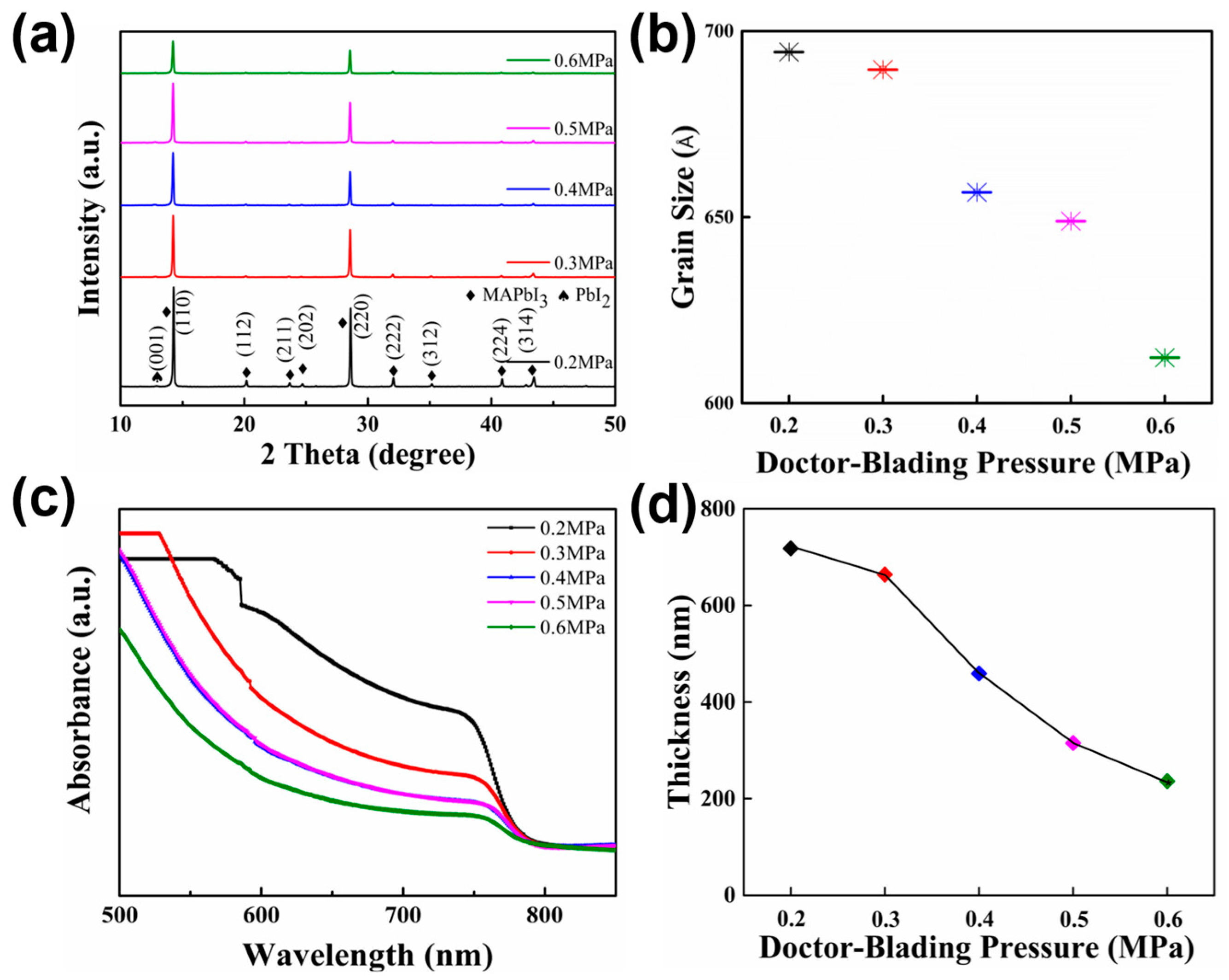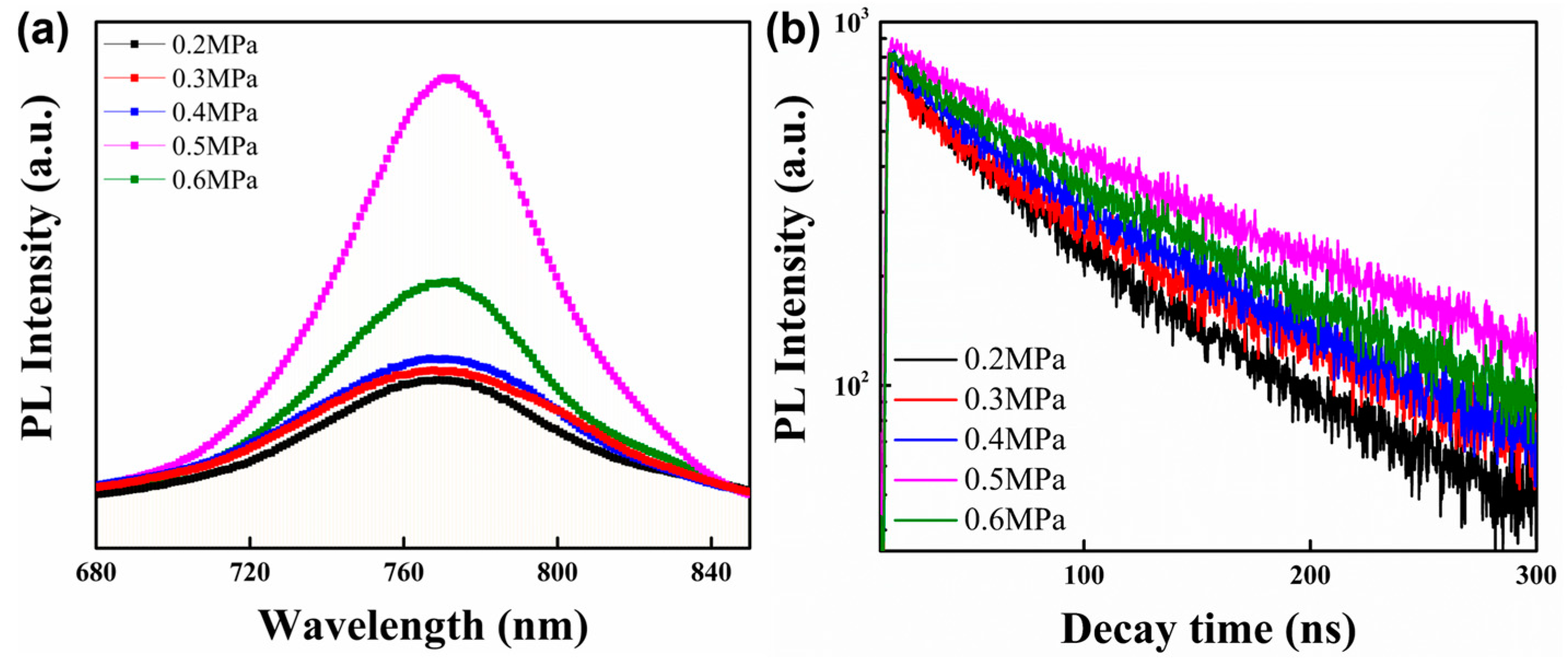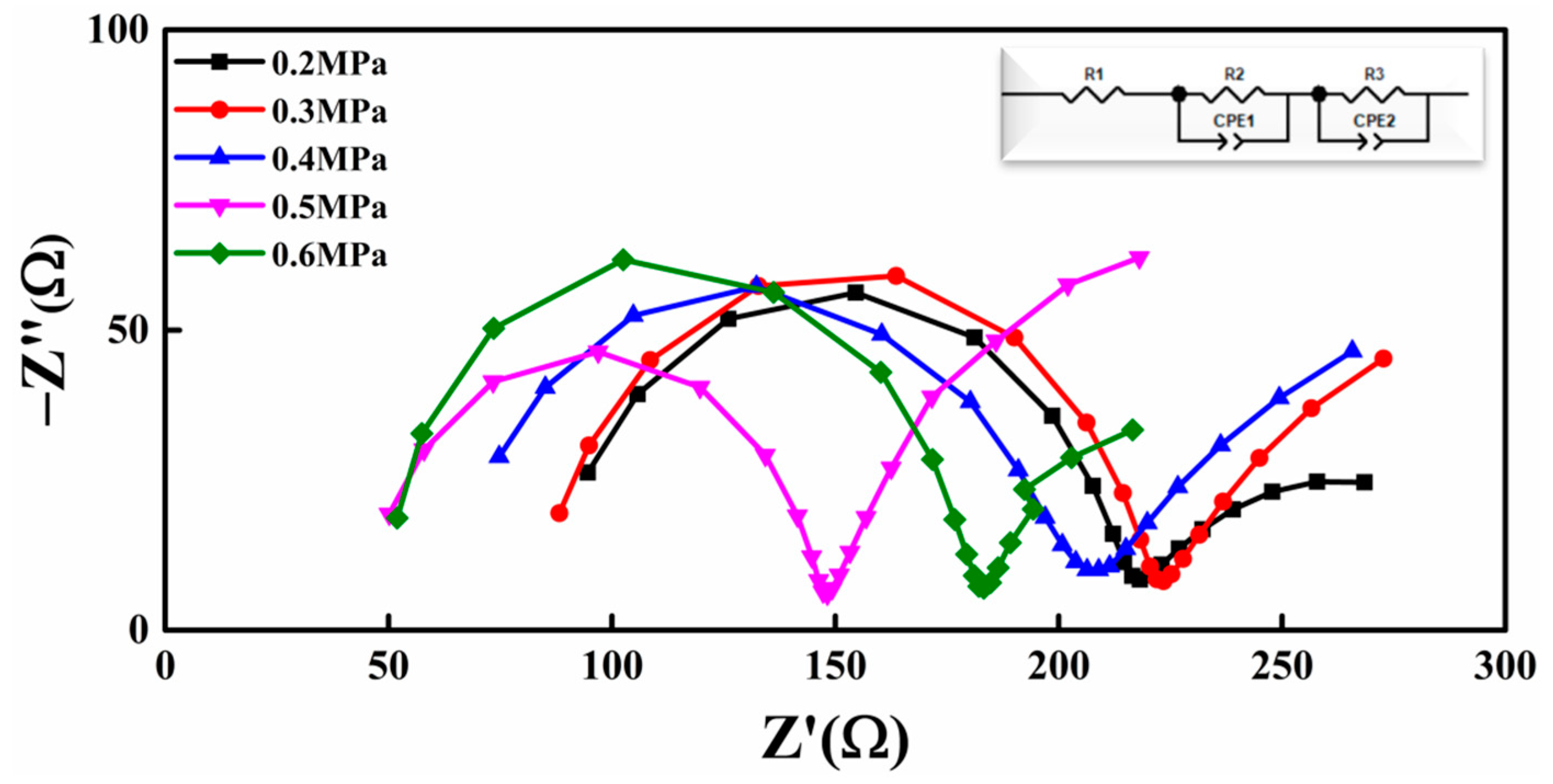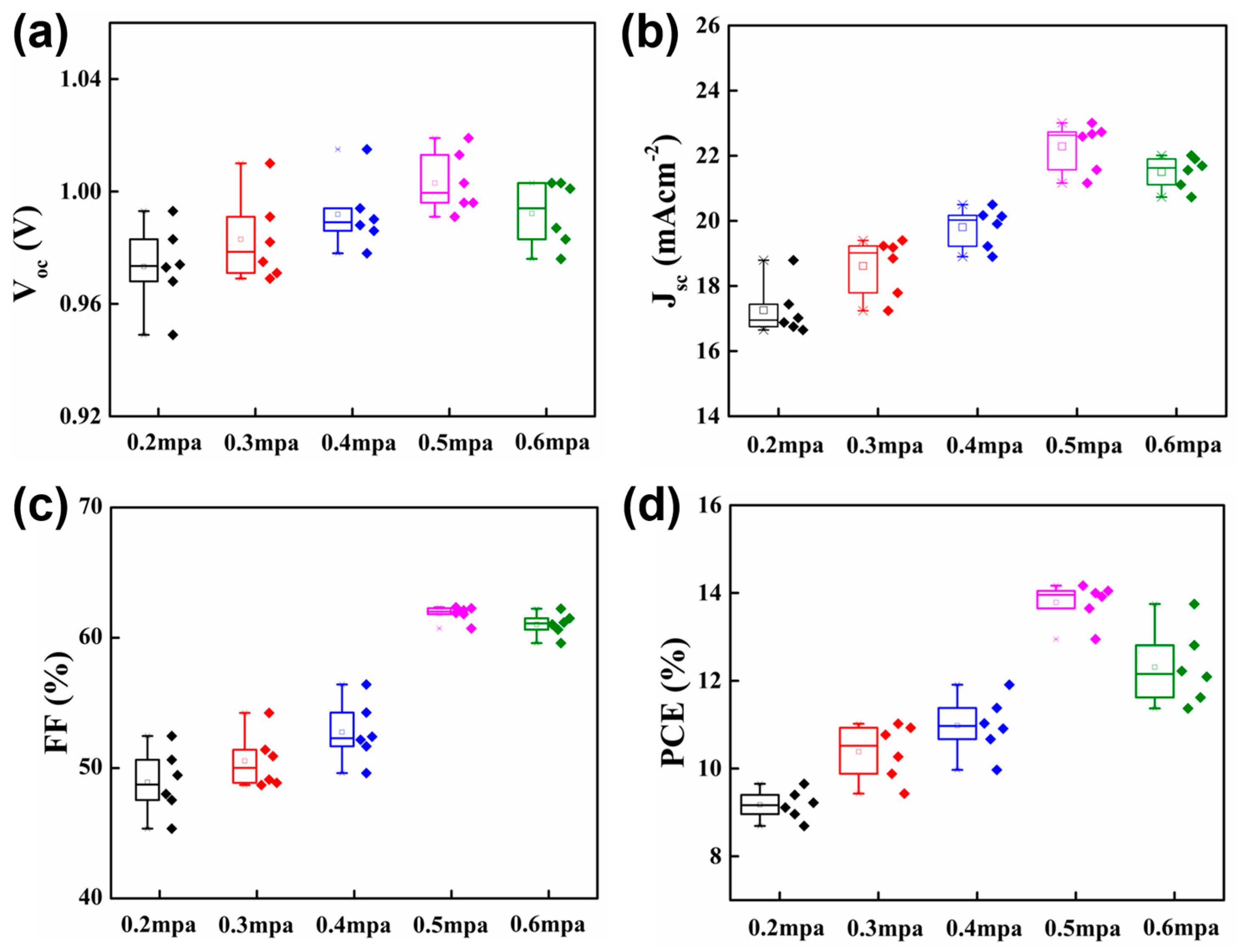Fully Printed HTL-Free MAPbI3 Perovskite Solar Cells with Carbon Electrodes
Abstract
1. Introduction
2. Experimental Section
2.1. Materials
2.2. Formation of SnO2 ETLs
2.3. Preparation of Perovskite Films with Doctor Blading and Fabrication of Devices
2.4. Characterizations
3. Results and Discussion
4. Conclusions
Supplementary Materials
Author Contributions
Funding
Institutional Review Board Statement
Informed Consent Statement
Data Availability Statement
Acknowledgments
Conflicts of Interest
References
- NREL. NREL Efficiency Chart. Available online: https://www.nrel.gov/pv/assets/pdfs/best-research-cell-efficiencies.pdf (accessed on 3 March 2023).
- Xu, L.; Chon, M.J.; Mills, B.; Thompson, C.V. Mechanical stress and morphology evolution in RuO2 thin film electrodes during lithiation and delithiation. J. Power Sources 2022, 552, 232260. [Google Scholar] [CrossRef]
- Xu, L.; Thompson, C.V. Mechanisms of the cyclic (de) lithiation of RuO2. J. Mater. Chem. A 2020, 8, 21872–21881. [Google Scholar] [CrossRef]
- Zhao, Y.; Zhu, K. Organic–inorganic hybrid lead halide perovskites for optoelectronic and electronic applications. Chem. Soc. Rev. 2016, 45, 655–689. [Google Scholar] [CrossRef] [PubMed]
- Zhang, W.; Eperon, G.E.; Snaith, H.J. Metal halide perovskites for energy applications. Nat. Energy 2016, 1, 16048. [Google Scholar] [CrossRef]
- Hajjiah, A.; Gamal, M.; Kandas, I.; Gorji, N.E.; Shehata, N. DFT and AMPS-1D simulation analysis of all-perovskite solar cells based on CsPbI3/FAPbI3 bilayer structure. Sol. Energy Mater. Sol. Cells 2022, 248, 112026. [Google Scholar] [CrossRef]
- Li, X.; Bi, D.; Yi, C.; Décoppet, J.-D.; Luo, J.; Zakeeruddin, S.M.; Hagfeldt, A.; Grätzel, M. A vacuum flash–assisted solution process for high-efficiency large-area perovskite solar cells. Science 2016, 353, 58–62. [Google Scholar] [CrossRef]
- Ding, B.; Li, Y.; Huang, S.-Y.; Chu, Q.-Q.; Li, C.-X.; Li, C.-J.; Yang, G.-J. Material nucleation/growth competition tuning towards highly reproducible planar perovskite solar cells with efficiency exceeding 20%. J. Mater. Chem. A 2017, 5, 6840–6848. [Google Scholar] [CrossRef]
- Han, Q.; Ding, J.; Bai, Y.; Li, T.; Ma, J.-Y.; Chen, Y.-X.; Zhou, Y.; Liu, J.; Ge, Q.-Q.; Chen, J. Carrier dynamics engineering for high-performance electron-transport-layer-free perovskite photovoltaics. Chem 2018, 4, 2405–2417. [Google Scholar] [CrossRef]
- Wu, Y.; Xie, F.; Chen, H.; Yang, X.; Su, H.; Cai, M.; Zhou, Z.; Noda, T.; Han, L. Thermally stable MAPbI3 perovskite solar cells with efficiency of 19.19% and area over 1 cm2 achieved by additive engineering. Adv. Mater. 2017, 29, 1701073. [Google Scholar] [CrossRef]
- Yang, M.; Zhou, Y.; Zeng, Y.; Jiang, C.S.; Padture, N.P.; Zhu, K. Square-centimeter solution-processed planar CH3NH3PbI3 perovskite solar cells with efficiency exceeding 15%. Adv. Mater. 2015, 27, 6363–6370. [Google Scholar] [CrossRef]
- Xiao, M.; Huang, F.; Huang, W.; Dkhissi, Y.; Zhu, Y.; Etheridge, J.; Gray-Weale, A.; Bach, U.; Cheng, Y.B.; Spiccia, L. A fast deposition-crystallization procedure for highly efficient lead iodide perovskite thin-film solar cells. Angew. Chem. Int. Ed. 2014, 53, 9898–9903. [Google Scholar] [CrossRef] [PubMed]
- Chen, H.; Ye, F.; Tang, W.; He, J.; Yin, M.; Wang, Y.; Xie, F.; Bi, E.; Yang, X.; Grätzel, M. A solvent-and vacuum-free route to large-area perovskite films for efficient solar modules. Nature 2017, 550, 92–95. [Google Scholar] [CrossRef]
- Ye, F.; Chen, H.; Xie, F.; Tang, W.; Yin, M.; He, J.; Bi, E.; Wang, Y.; Yang, X.; Han, L. Soft-cover deposition of scaling-up uniform perovskite thin films for high cost-performance solar cells. Energy Environ. Sci. 2016, 9, 2295–2301. [Google Scholar] [CrossRef]
- Padhiar, M.A.; Wang, M.; Ji, Y.; Yang, Z.; Zhou, Y.; Qiu, H.; Wang, H.; Shah, A.A.; Bhatti, A.S. Stable CsPbX3 (Br/Cl) Perovskite Nanocrystal Layer Passivated with Al-Doped CdSe for Blue Light-Emitting Diodes. ACS Appl. Nano Mater. 2021, 5, 908–916. [Google Scholar] [CrossRef]
- Xu, L.; Meng, T.; Zheng, X.; Li, T.; Brozena, A.H.; Mao, Y.; Zhang, Q.; Clifford, B.C.; Rao, J.; Hu, L. Nanocellulose-Carboxymethylcellulose Electrolyte for Stable, High-Rate Zinc-Ion Batteries. Adv. Funct. Mater. 2023, 33, 2302098. [Google Scholar] [CrossRef]
- Wu, M.; Zhang, Y.; Xu, L.; Yang, C.; Hong, M.; Cui, M.; Clifford, B.C.; He, S.; Jing, S.; Yao, Y. A sustainable chitosan-zinc electrolyte for high-rate zinc-metal batteries. Matter 2022, 5, 3402–3416. [Google Scholar] [CrossRef]
- Huang, H.; Shi, J.; Zhu, L.; Li, D.; Luo, Y.; Meng, Q. Two-step ultrasonic spray deposition of CH3NH3PbI3 for efficient and large-area perovskite solar cell. Nano Energy 2016, 27, 352–358. [Google Scholar] [CrossRef]
- Barrows, A.T.; Pearson, A.J.; Kwak, C.K.; Dunbar, A.D.; Buckley, A.R.; Lidzey, D.G. Efficient planar heterojunction mixed-halide perovskite solar cells deposited via spray-deposition. Energy Environ. Sci. 2014, 7, 2944–2950. [Google Scholar] [CrossRef]
- Zuo, C.; Vak, D.; Angmo, D.; Ding, L.; Gao, M. One-step roll-to-roll air processed high efficiency perovskite solar cells. Nano Energy 2018, 46, 185–192. [Google Scholar] [CrossRef]
- Wei, Z.; Chen, H.; Yan, K.; Yang, S. Inkjet printing and instant chemical transformation of a CH3NH3PbI3/nanocarbon electrode and interface for planar perovskite solar cells. Angew. Chem. Int. Ed. 2014, 53, 13239–13243. [Google Scholar] [CrossRef]
- Mei, A.; Li, X.; Liu, L.; Ku, Z.; Liu, T.; Rong, Y.; Xu, M.; Hu, M.; Chen, J.; Yang, Y. A hole-conductor–free, fully printable mesoscopic perovskite solar cell with high stability. Science 2014, 345, 295–298. [Google Scholar] [CrossRef] [PubMed]
- Lee, J.-W.; Na, S.-I.; Kim, S.-S. Efficient spin-coating-free planar heterojunction perovskite solar cells fabricated with successive brush-painting. J. Power Sources 2017, 339, 33–40. [Google Scholar] [CrossRef]
- Koza, J.A.; Hill, J.C.; Demster, A.C.; Switzer, J.A. Epitaxial electrodeposition of methylammonium lead iodide perovskites. Chem. Mater. 2016, 28, 399–405. [Google Scholar] [CrossRef]
- Deng, Y.; Peng, E.; Shao, Y.; Xiao, Z.; Dong, Q.; Huang, J. Scalable fabrication of efficient organolead trihalide perovskite solar cells with doctor-bladed active layers. Energy Environ. Sci. 2015, 8, 1544–1550. [Google Scholar] [CrossRef]
- Di Giacomo, F.; Shanmugam, S.; Fledderus, H.; Bruijnaers, B.J.; Verhees, W.J.; Dorenkamper, M.S.; Veenstra, S.C.; Qiu, W.; Gehlhaar, R.; Merckx, T. Up-scalable sheet-to-sheet production of high efficiency perovskite module and solar cells on 6-in. substrate using slot die coating. Sol. Energy Mater. Sol. Cells 2018, 181, 53–59. [Google Scholar] [CrossRef]
- Vak, D.; Hwang, K.; Faulks, A.; Jung, Y.S.; Clark, N.; Kim, D.Y.; Wilson, G.J.; Watkins, S.E. 3D printer based slot-die coater as a lab-to-fab translation tool for solution-processed solar cells. Adv. Energy Mater. 2015, 5, 1401539. [Google Scholar] [CrossRef]
- Ye, F.; Tang, W.; Xie, F.; Yin, M.; He, J.; Wang, Y.; Chen, H.; Qiang, Y.; Yang, X.; Han, L. Low-Temperature Soft-Cover Deposition of Uniform Large-Scale Perovskite Films for High-Performance Solar Cells. Adv. Mater. 2017, 29, 1701440. [Google Scholar] [CrossRef] [PubMed]
- Luo, J.; Xia, J.; Yang, H.; Sun, C.; Li, N.; Malik, H.A.; Shu, H.; Wan, Z.; Zhang, H.; Brabec, C.J. A pressure process for efficient and stable perovskite solar cells. Nano Energy 2020, 77, 105063. [Google Scholar] [CrossRef]
- Schackmar, F.; Eggers, H.; Frericks, M.; Richards, B.S.; Lemmer, U.; Hernandez-Sosa, G.; Paetzold, U.W. Perovskite solar cells with all-inkjet-printed absorber and charge transport layers. Adv. Mater. Technol. 2021, 6, 2000271. [Google Scholar] [CrossRef]
- Li, S.; Xie, H.; Dong, Q.; Jing, S.; Li, T.; Xu, L.; Hu, L. Synthesizing Carbon-Supported, High-Loading, Ultra-Small Pt3Ni Nanoparticles via Tuning the Surface Electrostatic Effect. Small Struct. 2023, 4, 2200176. [Google Scholar] [CrossRef]
- Song, S.; Hörantner, M.T.; Choi, K.; Snaith, H.J.; Park, T. Inducing swift nucleation morphology control for efficient planar perovskite solar cells by hot-air quenching. J. Mater. Chem. A 2017, 5, 3812–3818. [Google Scholar] [CrossRef]
- Chalkias, D.A.; Mourtzikou, A.; Katsagounos, G.; Karavioti, A.; Kalarakis, A.N.; Stathatos, E. Suppression of Coffee-Ring Effect in Air-Processed Inkjet-Printed Perovskite Layer toward the Fabrication of Efficient Large-Sized All-Printed Photovoltaics: A Perovskite Precursor Ink Concentration Regulation Strategy. Sol. RRL 2022, 6, 2200196. [Google Scholar] [CrossRef]
- He, M.; Li, B.; Cui, X.; Jiang, B.; He, Y.; Chen, Y.; O’Neil, D.; Szymanski, P.; Ei-Sayed, M.A.; Huang, J. Meniscus-assisted solution printing of large-grained perovskite films for high-efficiency solar cells. Nat. Commun. 2017, 8, 16045. [Google Scholar] [CrossRef] [PubMed]
- Zhang, C.; Yin, X.; Chen, G.; Sang, Z.; Yang, Y.; Que, W. High-Performance Photodetector with a-IGZO/PbS Quantum Dots Heterojunction. ACS Photonics 2023, 10, 790–800. [Google Scholar] [CrossRef]
- Zhang, Y.; Cui, Q.-p.; Shao, F.-q.; Wang, J.-s.; Zhao, H.-y. Influence of air-knife wiping on coating thickness in hot-dip galvanizing. J. Iron Steel Res. Int. 2012, 19, 70–78. [Google Scholar] [CrossRef]
- Cho, T.-S.; Kwon, Y.-D.; Kwon, S.-B. A study of the influence of air-knife tilting on coating thickness in hot-dip galvanizing. J. Therm. Sci. 2009, 18, 262–267. [Google Scholar] [CrossRef]
- Ghosh, A.K.; Jeong, B.-H.; Huang, X.; Hoek, E.M. Impacts of reaction and curing conditions on polyamide composite reverse osmosis membrane properties. J. Membr. Sci. 2008, 311, 34–45. [Google Scholar] [CrossRef]
- Kwon, S.-B.; Lee, D.-W.; Kwon, Y.-D. Experimental and computational studies on Coanda nozzle flow for the air knife application. J. Therm. Sci. 2007, 16, 164–169. [Google Scholar] [CrossRef]
- Zhou, Y.; Zhao, Y. Chemical stability and instability of inorganic halide perovskites. Energy Environ. Sci. 2019, 12, 1495–1511. [Google Scholar] [CrossRef]
- Maity, K.; Pal, U.; Mishra, H.K.; Maji, P.; Sadhukhan, P.; Mallick, Z.; Das, S.; Mondal, B.; Mandal, D. Piezo-phototronic effect in highly stable CsPbI3-PVDF composite for self-powered nanogenerator and photodetector. Nano Energy 2022, 92, 106743. [Google Scholar] [CrossRef]
- Iqbal, S.; Xie, H.; Yin, X.; Guo, Y.; Zhang, C.; Liu, D.; Wang, B.; Gao, B.; Que, W. Methylamine-Based Method to Deposit MAPbI3 Nanoscale-Thick Films for Efficient Perovskite Solar Cells with Carbon Electrodes. ACS Appl. Nano Mater. 2022, 5, 4112–4118. [Google Scholar] [CrossRef]
- Jeon, N.J.; Noh, J.H.; Kim, Y.C.; Yang, W.S.; Ryu, S.; Seok, S.I. Solvent engineering for high-performance inorganic–organic hybrid perovskite solar cells. Nat. Mater. 2014, 13, 897–903. [Google Scholar] [CrossRef] [PubMed]
- Zhang, Z.; Men, B.; Liu, Y.; Gao, H.; Mao, Y. Effects of precursor solution composition on the performance and IV hysteresis of perovskite solar cells based on CH3NH3PbI3-xClx. Nanoscale Res. Lett. 2017, 12, 84. [Google Scholar] [CrossRef][Green Version]
- Liu, G.; Zheng, H.; Xu, X.; Zhu, L.; Alsaedi, A.; Hayat, T.; Pan, X.; Dai, S. Efficient solar cells with enhanced humidity and heat stability based on benzylammonium–caesium–formamidinium mixed-dimensional perovskites. J. Mater. Chem. A 2018, 6, 18067–18074. [Google Scholar] [CrossRef]
- Yang, D.; Yang, R.; Ren, X.; Zhu, X.; Yang, Z.; Li, C.; Liu, S. Hysteresis-suppressed high-efficiency flexible perovskite solar cells using solid-state ionic-liquids for effective electron transport. Adv. Mater. 2016, 28, 5206–5213. [Google Scholar] [CrossRef]
- Miao, Y.; Chen, Y.; Chen, H.; Wang, X.; Zhao, Y. Using steric hindrance to manipulate and stabilize metal halide perovskites for optoelectronics. Chem. Sci. 2021, 12, 7231–7247. [Google Scholar] [CrossRef]
- Zhou, H.; Shi, Y.; Wang, K.; Dong, Q.; Bai, X.; Xing, Y.; Du, Y.; Ma, T. Low-Temperature Processed and Carbon-Based Zno/Ch3nh3pbi3/C Planar Heterojunction Perovskite Solar Cells. J. Phys. Chem. C 2015, 119, 4600–4605. [Google Scholar] [CrossRef]
- Cheng, N.; Liu, P.; Qi, F.; Xiao, Y.; Yu, W.; Yu, Z.; Liu, W.; Guo, S.-S.; Zhao, X.-Z. Multi-walled carbon nanotubes act as charge transport channel to boost the efficiency of hole transport material free perovskite solar cells. J. Power Sources 2016, 332, 24–29. [Google Scholar] [CrossRef]
- Nouri, E.; Mohammadi, M.R.; Lianos, P. Inverted perovskite solar cells based on lithium-functionalized graphene oxide as an electron-transporting layer. Chem. Commun. 2017, 53, 1630–1633. [Google Scholar] [CrossRef]
- Xu, X.; Zhang, H.; Cao, K.; Cui, J.; Lu, J.; Zeng, X.; Shen, Y.; Wang, M. Lead Methylammonium Triiodide Perovskite-Based Solar Cells: An Interfacial Charge-Transfer Investigation. Chemsuschem 2014, 7, 3088–3094. [Google Scholar] [CrossRef]
- Li, J.; Yao, J.X.; Liao, X.Y.; Yu, R.L.; Xia, H.R.; Sun, W.T.; Peng, L.M. A contact study in hole conductor free perovskite solar cells with low temperature processed carbon electrodes. RSC Adv. 2017, 7, 20732–20737. [Google Scholar] [CrossRef]
- Xiao, Y.; Cheng, N.; Kondamareddy, K.K.; Wang, C.; Liu, P.; Guo, S.; Zhao, X.Z. W-doped TiO2 mesoporous electron transport layer for efficient hole transport material free perovskite solar cells employing carbon counter electrodes. J. Power Sources 2017, 342, 489–494. [Google Scholar] [CrossRef]
- Chen, M.; Zha, R.H.; Yuan, Z.Y.; Jing, Q.S.; Huang, Z.Y.; Yang, X.K.; Yang, S.M.; Zhao, X.H.; Xu, D.L.; Zou, G.D. Boron and phosphorus co-doped carbon counter electrode for efficient hole-conductor-free perovskite solar cell. Chem. Eng. J. 2017, 313, 791–800. [Google Scholar] [CrossRef]
- Zhang, C.; Luo, Y.; Chen, X.; Chen, Y.; Sun, Z.; Huang, S. Effective improvement of the photovoltaic performance of carbon-based perovskite solar cells by additional solvents. Nanomicro. Lett. 2016, 8, 347–357. [Google Scholar]
- Duan, M.; Hu, Y.; Mei, A.; Rong, Y.; Han, H. Printable carbon-based hole-conductor-free mesoscopic perovskite solar cells: From lab to market. Mater. Today Energy 2018, 7, 221–231. [Google Scholar] [CrossRef]
- Chen, J.; Xiong, Y.; Rong, Y.; Mei, A.; Sheng, Y.; Jiang, P.; Hu, Y.; Li, X.; Han, H. Solvent effect on the hole-conductor-free fully printable perovskite solar cells. Nano Energy 2016, 27, 130–137. [Google Scholar] [CrossRef]
- Rong, Y.; Hou, X.; Hu, Y.; Mei, A.; Liu, L.; Wang, P.; Han, H. Synergy of ammonium chloride and moisture on perovskite crystallization for efficient printable mesoscopic solar cells. Nat. Commun. 2017, 8, 14555. [Google Scholar] [CrossRef]
- Liu, Z.; Zhang, M.; Xu, X.; Bu, L.; Zhang, W.; Li, W.; Zhao, Z.; Wang, M.; Cheng, Y.-B.; He, H. p-Type mesoscopic NiO as an active interfacial layer for carbon counter electrode based perovskite solar cells. Dalton Trans. 2014, 44, 3967–3973. [Google Scholar] [CrossRef]
- Liu, H.; Dong, M.; Huang, W.; Gao, J.; Dai, K.; Guo, J.; Zheng, G.; Liu, C.; Shen, C.; Guo, Z. Lightweight conductive graphene/thermoplastic polyurethane foams with ultrahigh compressibility for piezoresistive sensing. J. Mater. Chem. C 2016, 5, 73–83. [Google Scholar] [CrossRef]
- Chang, X.; Li, W.; Chen, H.; Zhu, L.; Liu, H.; Geng, H.; Xiang, S.; Liu, J.; Zheng, X.; Yang, Y.; et al. Colloidal precursor-induced growth of ultra-even CH3NH3PbI3 for high-performance paintable carbon-based perovskite solar cells. ACS Appl. Mater. Interfaces 2016, 8, 30184–30192. [Google Scholar] [CrossRef]
- Tsai, C.-M.; Wu, G.-W.; Narra, S.; Chang, H.-M.; Mohanta, N.; Wu, H.-P.; Wang, C.-L.; Diau, E.W.-G. Control of preferred orientation with slow crystallization for carbon-based mesoscopic perovskite solar cells attaining efficiency 15%. J. Mater. Chem. A 2016, 5, 739–747. [Google Scholar] [CrossRef]
- Chen, H.; Wei, Z.; He, H.; Zheng, X.; Wong, K.S.; Yang, S. Solvent engineering boosts the efficiency of paintable carbon-based perovskite solar cells to beyond 14%. Adv. Energy Mater. 2016, 6, 1502087. [Google Scholar] [CrossRef]
- Chen, H.; Zheng, X.; Li, Q.; Yang, Y.; Xiao, S.; Hu, C.; Bai, Y.; Zhang, T.; Wong, K.S.; Yang, S. An amorphous precursor route to the conformable oriented crystallization of CH3NH3PbBr3in mesoporous scaffolds: Toward efficient and thermally stable carbon-based perovskite solar cells. J. Mater. Chem. A 2016, 4, 12897–12912. [Google Scholar] [CrossRef]
- Yue, G.; Chen, D.; Wang, P.; Zhang, J.; Hu, Z.; Zhu, Y. Low-temperature prepared carbon electrodes for hole-conductor-free mesoscopic perovskite solar cells. Electrochim. Acta 2016, 218, 84–90. [Google Scholar] [CrossRef]
- Zheng, X.; Chen, H.; Li, Q.; Yang, Y.; Wei, Z.; Bai, Y.; Qiu, Y.; Zhou, D.; Wong, K.S.; Yang, S. Boron Doping of Multiwalled Carbon Nanotubes Significantly Enhances Hole Extraction in Carbon-Based Perovskite Solar Cells. Nano Lett. 2017, 17, 2496–2505. [Google Scholar] [CrossRef] [PubMed]
- Wei, Z.; Chen, H.; Yan, K.; Zheng, X.; Yang, S. Hysteresis-free multi-walled carbon nanotube-based perovskite solar cells with a high fill factor. J. Mater. Chem. A 2015, 3, 24226–24231. [Google Scholar] [CrossRef]
- Feng, J.; Wang, W.J.; Hai, X.; Yu, Y.L.; Wang, J.H. Green preparation of nitrogen-doped carbon dots derived from silkworm chrysalis for cell imaging. J. Mater. Chem. B 2016, 4, 387–393. [Google Scholar] [CrossRef]
- Jena, A.K.; Miyasaka, T. Hysteresis Characteristics and Device Stability. In Organic-Inorganic Halide Perovskite Photovoltaics; Park, N.G., Grätzel, M., Miyasaka, T., Eds.; Springer: Cham, Switzerland, 2016. [Google Scholar] [CrossRef]
- Chen, J.; Rong, Y.; Mei, A.; Xiong, Y.; Liu, T.; Sheng, Y.; Jiang, P.; Hong, L.; Guan, Y.; Zhu, X.; et al. Hole-conductor-free fully printable mesoscopic solar cell with mixed-anion perovskite CH3NH3PbI (3−x)(BF4) x. Adv. Energy Mater. 2016, 6, 1502009. [Google Scholar] [CrossRef]
- Cao, K.; Cui, J.; Zhang, H.; Li, H.; Song, J.; Shen, Y.; Cheng, Y.; Wang, M. Efficient mesoscopic perovskite solar cells based on the CH 3 NH 3 PbI 2 Br light absorber. J. Mater. Chem. A 2015, 3, 9116–9122. [Google Scholar] [CrossRef]
- Liu, Z.; Shi, T.; Tang, Z.; Sun, B.; Liao, G. Using a low-temperature carbon electrode for preparing hole-conductor-free perovskite heterojunction solar cells under high relative humidity. Nanoscale 2016, 8, 7017–7023. [Google Scholar] [CrossRef]







| Samples (MPa) | τ1 (ns) | Fraction 1 (%) | τ2 (ns) | Fraction 2 (%) | τavg (ns) |
|---|---|---|---|---|---|
| 0.2 | 37.85 | 21.73 | 116.51 | 78.57 | 91.54 |
| 0.3 | 25.86 | 7.76 | 125.15 | 92.24 | 117.45 |
| 0.4 | 28.11 | 7.80 | 128.01 | 92.20 | 120.21 |
| 0.5 | 34.55 | 5.20 | 157.68 | 94.80 | 151.28 |
| 0.6 | 32.31 | 6.32 | 136.94 | 93.68 | 130.31 |
| Samples (MPa) | Voc (V) | Jsc (mA cm−2) | FF | PCE (%) |
|---|---|---|---|---|
| 0.2 | 0.99 | 18.71 | 0.52 | 9.65 |
| 0.3 | 1.01 | 19.40 | 0.56 | 11.02 |
| 0.4 | 1.02 | 20.50 | 0.54 | 11.38 |
| 0.5 | 1.01 | 22.77 | 0.61 | 14.17 |
| 0.6 | 1.00 | 21.90 | 0.61 | 13.47 |
| Samples (MPa) | Rs/Ω | Rct/Ω | Rrec/Ω |
|---|---|---|---|
| 0.2 | 67.08 | 129.8 | 97.3 |
| 0.3 | 66.91 | 138.0 | 189.2 |
| 0.4 | 56.67 | 148.5 | 252.5 |
| 0.5 | 44.10 | 102.5 | 345.7 |
| 0.6 | 45.62 | 133.8 | 306.8 |
Disclaimer/Publisher’s Note: The statements, opinions and data contained in all publications are solely those of the individual author(s) and contributor(s) and not of MDPI and/or the editor(s). MDPI and/or the editor(s) disclaim responsibility for any injury to people or property resulting from any ideas, methods, instructions or products referred to in the content. |
© 2023 by the authors. Licensee MDPI, Basel, Switzerland. This article is an open access article distributed under the terms and conditions of the Creative Commons Attribution (CC BY) license (https://creativecommons.org/licenses/by/4.0/).
Share and Cite
Iqbal, S.; Yin, X.; Wang, B.; Zhang, J.; Nisar, M.Z.; Zhang, J.; Que, W. Fully Printed HTL-Free MAPbI3 Perovskite Solar Cells with Carbon Electrodes. Coatings 2023, 13, 1338. https://doi.org/10.3390/coatings13081338
Iqbal S, Yin X, Wang B, Zhang J, Nisar MZ, Zhang J, Que W. Fully Printed HTL-Free MAPbI3 Perovskite Solar Cells with Carbon Electrodes. Coatings. 2023; 13(8):1338. https://doi.org/10.3390/coatings13081338
Chicago/Turabian StyleIqbal, Shoaib, Xingtian Yin, Boyang Wang, Jiawei Zhang, Muhammad Zubair Nisar, Jide Zhang, and Wenxiu Que. 2023. "Fully Printed HTL-Free MAPbI3 Perovskite Solar Cells with Carbon Electrodes" Coatings 13, no. 8: 1338. https://doi.org/10.3390/coatings13081338
APA StyleIqbal, S., Yin, X., Wang, B., Zhang, J., Nisar, M. Z., Zhang, J., & Que, W. (2023). Fully Printed HTL-Free MAPbI3 Perovskite Solar Cells with Carbon Electrodes. Coatings, 13(8), 1338. https://doi.org/10.3390/coatings13081338







